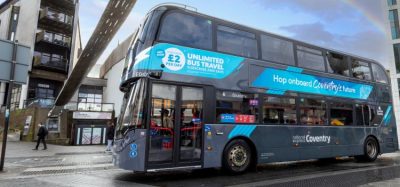Moving cities forward: shaping a better urban future
- Like
- Digg
- Del
- Tumblr
- VKontakte
- Buffer
- Love This
- Odnoklassniki
- Meneame
- Blogger
- Amazon
- Yahoo Mail
- Gmail
- AOL
- Newsvine
- HackerNews
- Evernote
- MySpace
- Mail.ru
- Viadeo
- Line
- Comments
- Yummly
- SMS
- Viber
- Telegram
- Subscribe
- Skype
- Facebook Messenger
- Kakao
- LiveJournal
- Yammer
- Edgar
- Fintel
- Mix
- Instapaper
- Copy Link
Posted: 12 March 2015 | Mathieu Lefevre, Executive Director, The New Cities Foundation
The world is urbanising at an unprecedented rate. More than ever, city leaders across the world need to plan strategically for shifting transport needs of citizens. The New Cities Foundation – an independent non-profit organisation with a mission to shape a better urban future for all – strongly advocates innovation and multi-sector collaboration when it comes to rethinking the future of urban mobility. The organisation’s Executive Director, Mathieu Lefevre, offers some examples of urban mobility innovations and discusses the potential impact they could bring to society as a whole…


Fast-forward yourself to 2050. By now, the global urban population will have reached seven billion, up from 3.9 million in 2014. Compare this to 1950, when the world’s urban population was 746 million.
As the world rapidly urbanises, city leaders and planners need to manage transport systems strategically, to ensure the changing needs of city dwellers are met. Those in charge of running transit systems must be bold enough to discard outmoded systems, and nimble enough to adopt innovative new solutions. Moving from A to B is a core part of nearly every citizen’s life, and, in many cities, existing transport systems that focus heavily on car use are simply not set up to cope with increasing numbers of commuters. Bound up with rising pollution levels and dwindling energy sources, transport is one of the most pressing challenges we face as we plan and manage our cities. At the New Cities Foundation, transport is central to our efforts to shape a better urban future. Changing mobility patterns ultimately affect many other aspects of urban life – such as economy, the world of work and citizen health and wellbeing – and in tandem, changing lifestyles will inevitably impact upon citizen commuting preferences. Moreover, an excellent transport system can boost a city’s competiveness, attracting talent, creating a thriving economy and contributing to its success in relation to other cities. We therefore argue that a flexible, forward-thinking approach to transport, favouring innovation and multi-sector collaboration, is vital as we reinvent and reimagine our cities.
We set up the New Cities Foundation in 2010 with a belief in the importance of a global, multi-sector platform for debate, discussion, information exchange and research on the future of cities. Right from the start, the Foundation has advocated cross-sector collaboration and openness to innovation. Our work on the future of urban transport weaves into our three core areas of work: thought leadership through media and events – including our annual New Cities Summit; collaborative research projects and our fast-growing hub of urban innovators.
In 2014, we hosted an event focusing on urban mobility entitled ‘Cities on the Move’. The one-day gathering took place at the company headquarters of our member, Google, in Mountain View, California. We brought together researchers and practitioners from across sectors for a series of talks and interactive workshops. The event exposed the myriad possibilities open to cities seeking to improve their infrastructure. To complement the event we launched a series of thought leadership papers. For many of our contributors, technology is a crucial tool for unlocking these alternative transportation modes. This is put succinctly by the authors Dr. Alexandre Bayen, Chancellor Professor at Berkeley and Michelle Harrington, Communications Specialist at California Partners for Advanced Transportation Technology (PATH), who argue: “A paradigm shift must occur. Transportation managers must look to technology to maximise system performance.” However, as Dr. Alexander Townsend of New York University warns in his article: “Despite solving issues in some regards,” the shift towards technology introduces several “new challenges for transportation planners, who need a comprehensive understanding on how they can accommodate the potential of these services”. The crux of the issue is, we need to find new transport solutions but they need to be sustainable and adapted to local needs.
Across the world, the quest to find viable, new transport solutions is no longer being led by authorities alone. Increasingly, young, bright urban innovators are utilising technology – such as smart phone apps and big data – to turn old systems on their head. Each year the New Cities Foundation identifies and provides a platform for urban innovators from a variety of disciplines. Several innovators have come to our attention due to their pioneering transport solutions. Take Rand Hindi, CEO of Snips, a French-based big data start-up that predicts social behaviour through algorithms. Since speaking at our New Cities Summit in São Paulo in 2013, Rand and his team began working with the Paris municipal public transport system to manage passenger flow on local ‘Transilien’ trains through a user-friendly app, ‘Tranquilien’, that helps passengers select less congested trains and even find out where they can find a seat. Or take Matthew George, CEO of Bridj, the world’s first smart mass transit system, founded in Cambridge, MA, which utilises big data and network optimisation to develop direct, faster transit routes within a city.
The sharing economy has of course given rise to new alternatives to individual car use, and several members of our urban innovator community have made developments in this realm. Whilst Uber dominates the global headlines, other, smaller start-ups in cities worldwide are offering locally tailored alternatives to driving and car ownership. In 2014, one of the three finalists of our AppMyCity! contest for the best new urban app was Djump, a peer-to-peer car sharing service founded in Brussels, that allows drivers with a car to register, users to request a ride, and drivers to answer the call. In 2012, one of the finalists for the contest was BuzzJourney, an Israeli app that offers passengers multi-modal transport routes combining taxis, public transport, walking, and measuring cost and CO2 emissions for different variations of each journey. Then there’s Let’s Ride, a start-up from Pune, India. This web and mobile app connects commuters from the same area for ridesharing, and is tailored for the local market. Of course, it goes without saying that city authorities across the world must analyse the economic implications of transport solutions based upon the sharing economy, and a balance needs to be struck between private enterprise and municipal transport management.
New city projects that are springing up across the world are fertile grounds for planners to experiment with innovation and test different modes of public-private partnership. Take the ambitious monorail system that is currently being built in Saudi Arabia connecting the major cities in the Kingdom to a brand new city and industrial hub, King Abdullah Economic City (KAEC). Within the city itself, efforts are being made to favour walking and biking in a society heavily reliant on cars, with footpaths and bike paths connecting strategic zones playing a crucial part of the master plan. In tandem, HafenCity Hamburg – Europe’s largest inner-city development project, favours walkability and bikeability within a ‘mixed use’ urban area combining offices, residential, cultural and commercial spaces. If leaders and planners of these cities seize the great opportunities these projects offer, this could pave the way for a more sustainable, economic urban future. This is a complex task, which involves balancing the requirement of a robust master plan with the need to remain adaptable to the needs of an urban population that is only just beginning, or does not yet exist. Last autumn we launched the Impact KAEC Fellowship, bringing three bright young graduates from Harvard Graduate School of Design to KAEC. By March 2015, the Fellows will have completed five months of living and working in the city, collaborating closely with city authorities to build a dynamic transport system. The Impact Fellowship springs from our belief that the cross-fertilisation of expertise is crucial to building better cities.
Whilst new cities represent a figurative laboratory for experimentation and innovation in transport systems, existing, ‘old’ metropolises urgently call for a different approach. As we plan our upcoming New Cities Summit3 in the sprawling, congested city of Jakarta, Indonesia – where cars travel at an average of 5km/h on main roads – we know that we have a long way to go before the world can reach a sustainable transport future. Following our previous Summit in Dallas, we picked Jakarta as this year’s host city, since this expanding metropolis encapsulates the huge challenges and opportunities faced by many rapidly urbanising centres in the region. Jakarta is estimated to lose US$3 billion a year because of traffic congestion, which cannot be separated from the high growth rate of vehicle ownership (9-11% per year), unsupported by road development (less than 1% a year). What can be done to prevent a major crisis in congested Asian metropolises such as Jakarta, Beijing and Delhi? What can we, the readers of this magazine, contribute to this discussion? What can we learn through tackling this challenge, in order to improve our own urban infrastructures in Europe?
In the weeks and months ahead, the New Cities Foundation will be talking to many actors across the world to pinpoint and discuss the major choke points in rapidly urbanising cities such as Jakarta. We’ll gather insights and case studies from the leaders of cities within our network who have tried and tested new transit solutions. And we’ll seek out brilliant innovators from across the world, to help us demonstrate to city leaders that the best solutions can often begin from the ground-up. Most of all, we aim to build up our dynamic mix of leaders, thinkers, entrepreneurs, designers and planners in order to continue our multi-voice conversation on the future of our cities.
Urban transport, like other aspects of urban life, can only be improved if we address the issue from different angles and perspectives, and if we ensure that solutions are adapted to local needs. It is in this way that we can build a bold, actionable plan for the future of our cities and citizens.
References
- Twitter @NewCitiesFound
- newcitiesfoundation.org
- newcitiessummit2015.org
Biography
Mathieu Lefevre is the Executive Director of the New Cities Foundation. Working closely with the Foundation’s Chairman and Trustees, Mathieu oversees the organisation’s strategy and its day-to-day operations. Previously, Mathieu worked for the World Bank in the area of governance and as a Political Officer for the UN Department of Peacekeeping Operations, serving in Afghanistan and the Middle East. Mathieu is a graduate of Harvard’s Kennedy School of Government and the London School of Economics. He is a citizen of France and the United States and has published articles in The Economist magazine, the Foundation for Strategic Research, SLUM Lab, the French Almanac of International Relations and the Afghanistan Analysts Network.
Related topics
Business Models, Transport Governance & Policy
Issue
Issue 1 2015
Related organisations
New Cities Foundation







